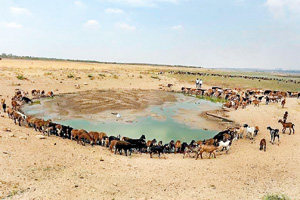Sunday Times 2
Parched India takes action to prevent unrest
A water crisis is becoming so severe in parts of India that one city has banned gatherings of more than five people around water storage points to prevent possible riots as water levels plummet in reservoirs. Drought has been declared in nine out of India’s 29 states. Hardest hit has been the western state of Maharashtra, with dangerously low water levels in nearly half of its districts .

Livestock around the almost dried-up Osman Sagar Lake, commonly known as Gandipet, on the outskirts of Hyderabad, Telangana, which is in the grip of a severe drought (AFP)
In one of the state’s cities, Latur, which has a population of 500,000, schools have started summer vacations early, the authorities have banned swimming pools from being filled and, for the first time, enforced orders to stop people from gathering near water tankers. The railway ministry has said it would soon send water to the city and surrounding villages by train.
“There have basically been two years of drought. Because of that there is difficulty,” said Mr. Pandurang Pole, the top official in the local administration. He said no violence has broken out over water.”We have appealed to residents to use water economically and judiciously and to avoid any unnecessary use of water.”
Residents of Latur, where hundreds of water tankers are now the key source of supply, say the water crisis is at its worst.
“We have been having problems for two years but this year is the height (of the water crisis),” said Mr. Pasha Patel of the Bharatiya Janata Party, who lives in Latur.
Many areas of India are prone to droughts, and water sources are already under stress from a population of 1.25 billion and growing. Monsoons that cross the southern Indian coastline in June, moving north and to the east before ending in September, are the main source of water. Their rains replenish ground water, fill water storage tanks and feed rivers.
But below-normal monsoon rains in 2014 and 2015, experts and officials said, due to the El Nino effect, have seen water levels plunge to new lows. According to Central Water Commission data released on March 17, levels in India’s 91 reservoirs that also provide water for hydropower have dipped to 27 per cent of total storage capacity.
Officials said this has had an impact on everything from planting of crops to hydropower generation and supply of drinking water.
“The water levels are the lowest in the last 10-year average. This is something to worry about… it will be worse if the monsoons are bad this year,” said an official who did not want to be quoted.
The Indian Meteorological Department has yet to release its monsoon forecast for the year.In the southern state of Karnataka, plummeting reservoir levels have prompted the state government to stop water from being diverted for agriculture, to prevent a drinking water crisis.
The water shortage has intensified rows between states over the sharing of river waters. Punjab has refused to go ahead with a canal project to share water with neighbouring Haryana. Experts said the key is in improving water management and preventing too much ground water from being extracted.
Mr Nitya Jacob, head of policy at WaterAid In India, said the key is to “optimise local storage” and “increase use of recycled water”. Dr Himanshu Kulkarni, head of the non-profit Advanced Centre for Water Resources Development and Management, said: “There was already an impending crisis. You need strong water governance, a long-term vision even as we go ahead with firefighting measures… The crisis is like an iceberg. The tip that you see is depletion of rivers… It is a far more complex problem.”
Courtesy The Straits Times, Singapore

